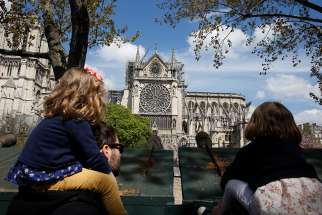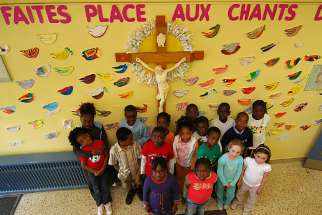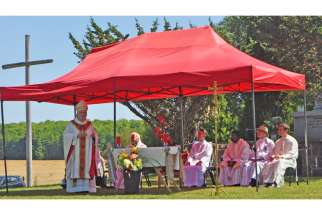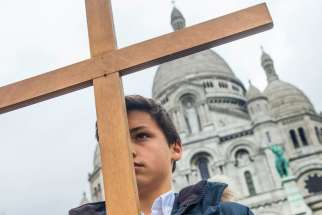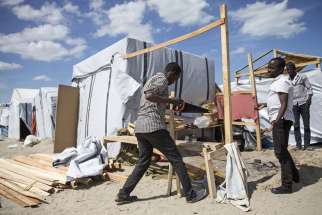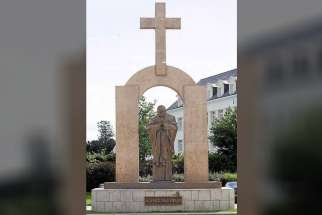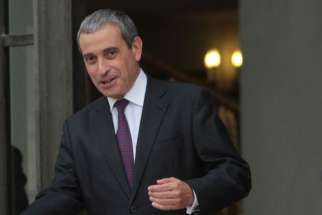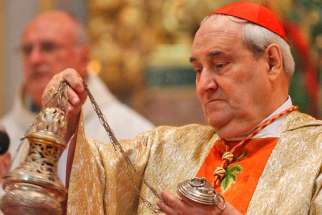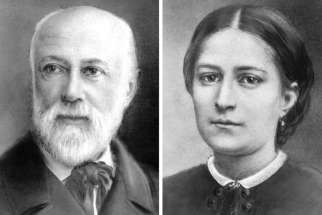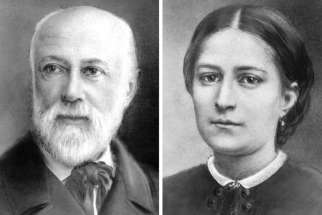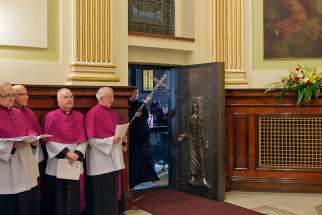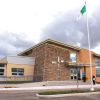MONTREAL - The fire that ravaged a large part of Notre Dame Cathedral in Paris offered an opportunity for French Catholics with Canadian connections to reflect on the impact the event can have on their faith.
Catholic parents fearing the worst in education cuts
Catholic parents fear the massive March 15 education cuts are just the opening salvo of a campaign to fold Ontario’s Catholic schools into a unified public system, while French Catholic trustees are warning of much deeper cuts to come.
New guide helps French Catholic-Muslim couples preparing to marry
PARIS - A day after Islamic extremists massacred 130 people in Paris last month, a Muslim-Catholic couple married in Lyon. It had to be a civil ceremony because the Muslim family refused to enter a church. Shocked by the attacks, some relatives even asked whether they should go ahead with the ceremony at all.
Cardinal Collins marks 400 years since first Mass in Ontario
LAFONTAINE, Ont. - Four centuries ago, the first Mass west of Quebec was celebrated in the Huron-Wendat village of Carhagouha. On Aug. 15, Toronto's Cardinal Thomas Collins returned to that spot to mark the 400th anniversary of the event.
PARIS - Catholic churches in France have been placed under police protection and urged to take extra security measures against possible Islamist attacks before the Aug. 15 feast of the Assumption.
OXFORD, England - French and British Catholic bishops urged their governments to settle a growing refugee crisis around the port of Calais, where highways have been blocked and migrants from Africa and the Middle East have died attempting illegal crossings of the Channel Tunnel, or Chunnel.
VATICAN CITY - A French court has told authorities in Ploermel, France, to remove the small town's statue of St. John Paul II on claims the statue's placement in a public square violated the separation of church and state.
VATICAN CITY - Despite media reports that Pope Francis refused the candidate France proposed as its next ambassador to the Holy See — speculating that it is due to the fact Laurent Stefanini is homosexual — the French government has yet to receive an official response from the Vatican, said a spokesperson for the French government.
Cardinal Jean-Claude Turcotte dead at 78
MONTREAL - Montreal's cardinal of the people, Archbishop Emeritus Jean-Claude Turcotte, is dead.
The popular cardinal, who served as Montreal's archbishop for 22 years, died April 8 in Montreal’s Marie-Clarac Hospital.
VATICAN CITY - Pope Francis has approved a miracle so that, for the first time, a married couple can be canonized together.
VATICAN CITY - Pope Francis is expected to canonize Blessed Louis and Zelie Martin, the parents of St. Therese of Lisieux, during the world Synod of Bishops on the family in October.
350,000 pass through Quebec Holy Door
A year of celebration in the Archdiocese of Quebec drew more than 350,000 pilgrims through the Holy Door of Quebec City’s Cathedral-Basilica of Notre Dame de Québec.
Sault’s new school aims to preserve French culture
For the French Catholic community in Sault Ste. Marie, Ont., the newly constructed École Notre-Dame-du-Sault will provide students with the sense of belonging necessary for preserving their French identity.
“The community really wanted us to unite all of our students at one site and offer students a high quality school where they get to start off in Kindergarden and finish off in Grade 12,” said Paul de la Riva, spokesperson for the Conseil scolaire catholique du Nouvel-Ontario (CSCNO). “The board’s main goal is to keep our students from Kindergarden to Grade 12.”
But that isn’t what had been happening in northern Ontario’s third largest city. While there are two elementary schools — École Cardinal-Léger and École Notre-Dame-des-Écoles which was expanded to become the new school — it had been renting space at a local Catholic secondary school to house its own high school.
De la Riva said this lack of independent identity caused many students to move to the English boards, either public or Catholic, when they entered Grade 9.
“All our schools weren’t really up to par, they were old schools and they really weren’t meeting the needs of the community,” he said. “When you’re renting a spot or area in another school you may have your own wing but you’re always looking at what the others are doing, the bigger section of the school. By having our students in their own building it will build a sense of belonging.”
That’s what prompted the five-year, $12.5- million project of renovating, expanding and rebranding École Notre-Dame-des-Écoles for which the province put forward $11.26 million, with the additional funds coming from the board’s budget.
It isn’t just CSCNO students who will benefit from this new building, which held its official opening ceremony on Oct. 26. Along with housing the more than 300 students from Junior Kindergarden to Grade 12, the building will also host the French-language adult learning centre and the Centre francophone de Sault-Ste-Marie, as well as play a supportive role for many off site organizations.
It is hoped this will help establish the new school as a hub for francophone pride.
“The school’s community component is something we hold dear and which will certainly contribute to its growth and to the vitality of the francophone community in Sault Ste. Marie and the Algoma District,” said Lyse-Anne Papineau, CSCNO director of education, in a news release. “We strongly believe that the new school will become a key City of Sault Ste. Marie partner for many years to come.”
Not only does the board hope that more students will remain pupils of its system, the board also hopes to attract new students to the francophone system with the modern school which has a capacity of 565 students. To help ensure success in maxing out this expanded capacity, the school houses a French-language day care program for up to 30 children.
“It’s really important to support the parents in preserving their language,” said de la Riva. “If children are not going to French schools, we know that one generation from now you’re losing many francophones who may have knowledge of the language but will not have the skills or capacity to really speak the language, transmit the language and culture to their kids.”
French board numbers on the rise
While many of their Anglophone counterparts struggle with declining enrollment, the French Catholic District School Board of south-central Ontario opened three new schools this year to accommodate an increasing student population.
“The school board has an increase of students every single year and this year is not different,” said Réjean Sirois, director of education for the French Catholic school board which services south-central Ontario. “We’ll be over 14,500 students this year. It is an increase of four per cent.”
Since 2006 the student population has increased by about 2,500, placing a heightened demand on the board’s infrastructure.
On Sept. 4 the doors opened to the French board’s new elementary schools, École du Sacré-Coeur in Toronto and École Eléméntaire Catholique Notre-Dame-de-la-Huronie in Collingwood, Ont. Meanwhile in downtown Toronto students of École Secondaire Catholique Saint-Frère-André, who were formerly educated at West Toronto Collegiate Institute, explored their new home-away-from-home.
Formed in 1998 the board is responsible for a geographic area stretching from the Niagara Peninsula to Georgian Bay. Currently the board, one of eight French first-language Catholic boards in the province, operates 51 schools across the more than 40,000 square kilometres it services.
“There is a demand for a French first-language Catholic education and it has been like that for the past eight or nine years,” said Sirois. “There are several factors for the increase in our student population but mainly (it’s because) we’re putting schools where we didn’t have schools before. In certain regions where we didn’t have schools we’re now offering the service.”
This year’s additions do not represent the end of expansion for the board either. There are three more facilities in the works.
“As we speak we are building two new schools and pretty soon we’ll start building another school for Oakville,” said Sirois.
While Sirois admits there are several factors which have led to this continuous growth, there is one component which stands out — parental awareness.
“People are more aware now that there is a French Catholic school board where the instruction is done in a French first language,” he said. “With all the publicity and the effort from our communication department we have been able to reach more parents.”
Although the curriculum follows the same provincial standards as the English boards, all of the material, social interaction and extra-curricular activities are French-spoken only, said Sirois, detailing the difference between his board and the public system’s French immersion programs.
“We recognize the excellent work of our parents who support their children in French education,” said Sirois. “We’re lucky to have devoted staff dedicated to the difference of French Catholic education and it’s a good place to be, let me tell you, it’s a good place to be right now.”
French carmaker Renault gives Pope electric minivans
VATICAN CITY - Thanks to a French automaker and an Italian utility, Pope Benedict XVI now has a pair of all-electric minivans and a series of recharging stations with which to power them.
Two custom-made editions of Renault's Kangoo Maxi Z.E. cars were delivered personally to the Pope Sept. 5 at the papal summer villa in Castel Gandolfo.
At a Vatican press conference the next day, representatives of Renault told reporters the two cars were made specifically for the Vatican.
The white version, with the papal stem on the front doors, was designed for the Pope to use, probably at Castel Gandolfo, but Jesuit Father Federico Lombardi, Vatican spokesman, said it also could be used on other occasions when the Pope is in the midst of a crowd.
The roof over the back seats opens and the side windows are removable, so it can be used as a popemobile, the Renault representatives said. It also has a retractable step to make it easier to get in and out of the vehicle.
On a full charge, they said, the Pope's car can cover 160 km. While they did not say how fast the Pope's Kangoo Maxi Z.E. could go, Renault says its unmodified version can reach speeds up to 125 km an hour.
The second Kangoo Maxi Z.E. given to the Pope was designed for the Vatican police force, the "gendarmeria Vaticana." Painted blue, the minivan has police lights on top and a white-and-gold stripe around the sides.
Pope Benedict, the Italian police who patrol St. Peter's Square, and the staff of Castel Gandolfo and the Vatican press office already use electric vehicles, which is why the Italian electric company ENEL has installed recharging stations at the Vatican as well as at the summer villa.


